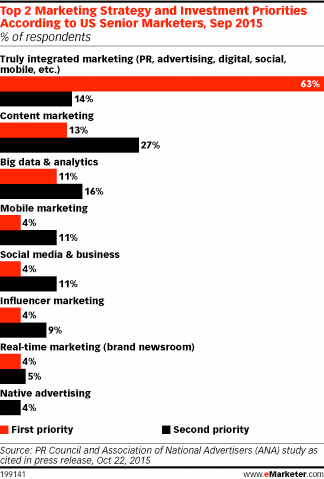How to Make Multichannel Marketing Work
June 14, 2016
![]() As consumers spend more time across a broader number of devices and channels, the case for multichannel marketing has never been clearer. But few companies are capable of integrating the required data sources, technologies and departments to make omnichannel marketing work, as explored in a new eMarketer report, “Making Multichannel Marketing Work Four Tactics Required for Omnichannel Success.”
As consumers spend more time across a broader number of devices and channels, the case for multichannel marketing has never been clearer. But few companies are capable of integrating the required data sources, technologies and departments to make omnichannel marketing work, as explored in a new eMarketer report, “Making Multichannel Marketing Work Four Tactics Required for Omnichannel Success.”
 Multichannel marketing can be defined simply as using multiple touchpoints to reach audiences. Given the general nature of the description, it is not uncommon to find it applied in vastly different ways. One marketer may describe the coordination of digital-only efforts as multichannel, while another might assume that merely maintaining a presence in multiple channels qualifies.
Multichannel marketing can be defined simply as using multiple touchpoints to reach audiences. Given the general nature of the description, it is not uncommon to find it applied in vastly different ways. One marketer may describe the coordination of digital-only efforts as multichannel, while another might assume that merely maintaining a presence in multiple channels qualifies.
More seasoned marketers understand that multichannel marketing isn’t just about executing in multiple channels but integrating them. This more holistic, omnichannel definition that includes online and offline channels is now the norm, as are hopes for its implementation. (In this vein, eMarketer considers this type of multichannel marketing analogous to omnichannel marketing and uses the terms interchangeably throughout this report.) A September 2015 survey by the PR Council and Association of National Advertisers (ANA) found that a truly integrated marketing strategy was far and away the top priority of US senior marketers.
 Accomplishing this is proving elusive. A June 2015 survey of CMOs worldwide conducted by The CMO Club found just 11% of respondents felt they had a sophisticated omnichannel strategy, meaning a cross-channel strategy that included online and offline channels. About a third of respondents were in the early stages, but the remaining 55% had yet to launch or had no plans to launch such a strategy.
Accomplishing this is proving elusive. A June 2015 survey of CMOs worldwide conducted by The CMO Club found just 11% of respondents felt they had a sophisticated omnichannel strategy, meaning a cross-channel strategy that included online and offline channels. About a third of respondents were in the early stages, but the remaining 55% had yet to launch or had no plans to launch such a strategy.
Though one might expect the portion of marketers possessing an omnichannel strategy to have risen since last year, companies are still struggling to keep pace with expanding media consumption habits, especially within digital.
In 2016, eMarketer estimates, the average US adult will consume almost 6 hours of digital media daily across mobile, desktops/laptops and other connected devices, such as an internet protocol TV (IPTV) or over-the-top (OTT) devices like a Roku.
Mobile, which includes smartphones and tablets, has brought significant frustrations to marketers in the past couple of years. With US mobile time spent projected to climb over the next several years, eroding time spent with desktops and laptops and even television, it will only continue to disrupt brands’ marketing efforts.
Keeping pace with digital consumption habits in a broad sense is challenging enough, but racing to cover all the channels and formats proves even harder. As time spent on core digital activities such as digital video, digital radio and social networking rises, marketers must hone their efforts to capitalize on these actions across search, email, shopping engines, news sites and many other properties at any time and on any device.
Courtesy of eMarketer



























